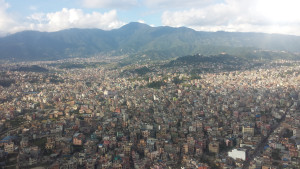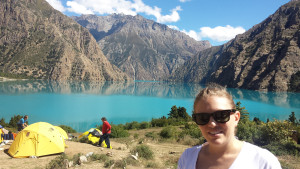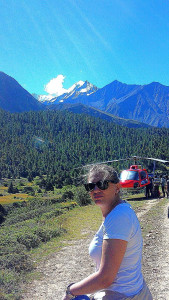My second journey to Nepal was in September 2014, only 4 months after my first diagnosis and surgery. My leg was not healing as fast as I hoped it would. I noticed a swelling and towards the end of each day it started to be painful again, but what the hell…. I was in Nepal and I was totally excited to be a part of this trip. Trekking on crutches can be quite adventurous too, right? Anyway, I didn’t let the trip be affected by a swollen knee and a little pain.
On a late afternoon, we headed to Kathmandu airport for a helicopter flight to Pokhara, where we would be staying over for one night before the actual trip starts. The advantage of a helicopter flight is that you fly much lower and you can admire the mountain and landscape scenery from above. The flight from Kathmandu to Pokhara took 30 minutes only.

Helicopter view of Kathmandu
We stayed at “The Lakeside Retreat”, a beautiful and peaceful resort with some great views over the first Himalayan mountain range (when weather permits). It provides all requirements you need after a trekking trip in the mountains. I highly recommend to stay there pre- or post-trekking.
The following morning started early at 4am. We had to be at Pokhara airport by 6am, as this was our scheduled departure time.
Our first destination for the day was Dolpo and the lake Phoksundo located in Dolpa district, in the north-western part of Nepal. This region, including Shey Phuksundo National Park (the largest national park in Nepal), borders with Tibet Autonomous Region of China. A 1 hour helicopter flight overlooking the magnificent Himalaya brought us to Dunai, which is the district’s headquarter at an altitude of 2,000 m along the river Bheri.
Here we had to stop briefly for two reasons: (1) show our permits to enter Shey Phuksundo National Park, and (2) to unload any unnecessary weight from the helicopter such as extra fuel for our return flight to Pokhara. Due to the drastic altitude ascent by over 1,500 m it is advisable for the helicopter to be as light as possible, hence we had to leave the gear and fuel behind that is not required. After a quick pit stop we started heading towards the national park, flying over waterfalls, monasteries, local villages and trekking camp sites. After only 15 minutes we reached the lake Phuksundo, a crystal blue beauty… simply breathtaking and makes you speechless. Phuksundo Lake is located in an altitude of 3,612 m and is the deepest lake in Nepal with a maximum depth of 145m. Due to the extreme altitude difference (from Pokhara at 1,400 m to a sudden altitude of 3,612) we were able to stay there only for a maximum of 1 hour. Such a sudden ascent to high altitude can cause severe altitude sickness, an illness that can occur above 2,500 meters if the body has not been acclimatized properly.

Lake Phuksundo

Heading to the helicopter at Lake Phuksundo
What does acclimatization mean? Basically, your body needs to adjust slowly to the low air pressure at highaltitude, meaning you may start trekking from a base camp, ascent by over 1500 m in one day, but then return back to base camp. Once your body gets used to it you can climb up further. That’s why a trekking adventure trip requires time.
So our time at Phuksundo was limited to exploring the site and we flew our drone over the lake (which then crashed into the water and all our beautiful video shots were gone). At some point one of us started to feel a bit nauseous (the first sight of altitude sickness) and it was time to head back to Pokhara after our quick refueling stop in Dunai. It was quite interesting to know that our helicopter pilot had an oxygen cannula to ensure he doesn’t feel any sickness whilst flying, whilst us passengers tolerated the low oxygen level and fell asleep.
Once we reached Pokhara we refueled the helicopter, picked up our luggage and headed up North to our next destination, Upper Mustang, where we would spend our next couples of days.